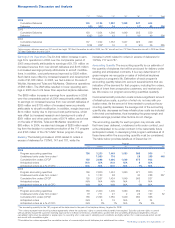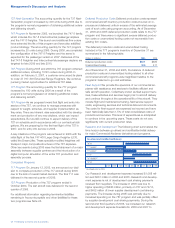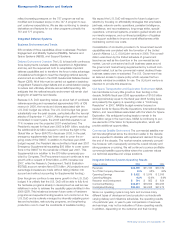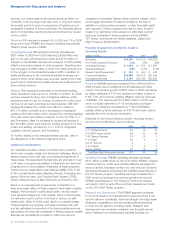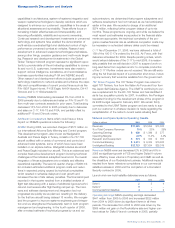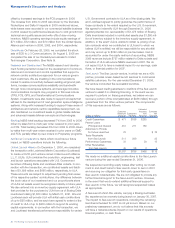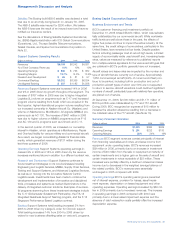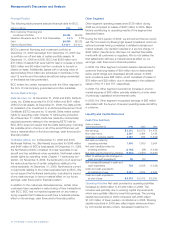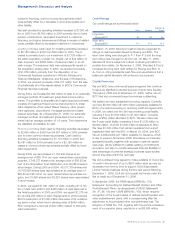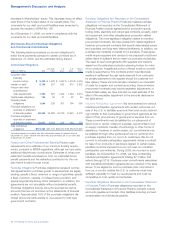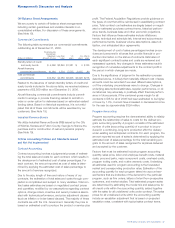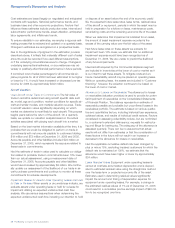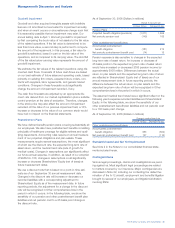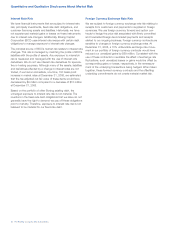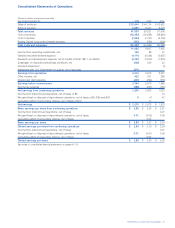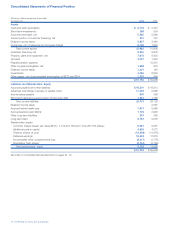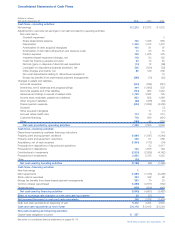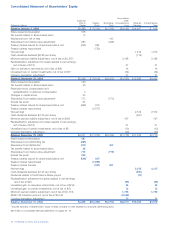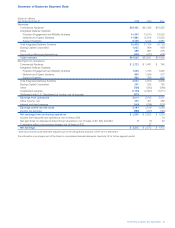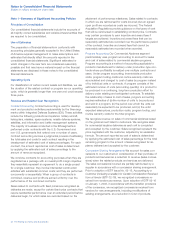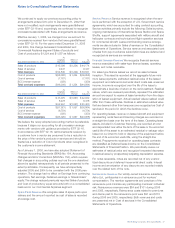Boeing 2006 Annual Report Download - page 39
Download and view the complete annual report
Please find page 39 of the 2006 Boeing annual report below. You can navigate through the pages in the report by either clicking on the pages listed below, or by using the keyword search tool below to find specific information within the annual report.
Off-Balance Sheet Arrangements
We are a party to certain off-balance sheet arrangements
including certain guarantees and variable interests in un-
consolidated entities. For discussion of these arrangements.
(See Note 19).
Commercial Commitments
The following table summarizes our commercial commitments
outstanding as of December 31, 2006.
Total Amounts
Committed/
Maximum Less than 1-3 4-5 After 5
(Dollars in millions) Amount of Loss 1 year years years years
Standby letters of credit
and surety bonds $««4,368 $2,849 $1,381 $«««««««3 $135
Aircraft financing
commercial commitments 10,164 1,534 5,525 3,025 80
Total commercial
commitments $14,532 $4,383 $6,906 $3,028 $215
Related to the issuance of certain standby letters of credit and
surety bonds included in the above table, we received advance
payments of $2,869 million as of December 31, 2006.
Aircraft financing commercial commitments include commit-
ments to arrange or provide financing related to aircraft on
order or under option for deliveries based on estimated earliest
funding dates. Based on historical experience, it is not antici-
pated that all of these commitments will be exercised by our
customers. (See Note 19).
Industrial Revenue Bonds
We utilize Industrial Revenue Bonds (IRB) issued by the City
of Wichita, Kansas and Fulton County, Georgia to finance the
purchase and/or construction of real and personal property.
(See Note 19).
Critical Accounting Policies and Standards Issued
and Not Yet Implemented
Contract Accounting
Contract accounting involves a judgmental process of estimat-
ing the total sales and costs for each contract, which results in
the development of estimated cost of sales percentages. For
each contract, the amount reported as cost of sales is deter-
mined by applying the estimated cost of sales percentage to
the amount of revenue recognized.
Due to the size, length of time and nature of many of our
contracts, the estimation of total sales and costs through com-
pletion is complicated and subject to many variables. Total con-
tract sales estimates are based on negotiated contract prices
and quantities, modified by our assumptions regarding contract
options, change orders, incentive and award provisions associ-
ated with technical performance, and price adjustment clauses
(such as inflation or index-based clauses). The majority of these
contracts are with the U.S. Government. Generally the price is
based on estimated cost to produce the product or service plus
profit. The Federal Acquisition Regulations provide guidance on
the types of cost that will be reimbursed in establishing contract
price. Total contract cost estimates are largely based on negoti-
ated or estimated purchase contract terms, historical perform-
ance trends, business base and other economic projections.
Factors that influence these estimates include inflationary
trends, technical and schedule risk, internal and subcontractor
performance trends, business volume assumptions, asset uti-
lization, and anticipated labor agreements.
The development of cost of sales percentages involves proce-
dures and personnel in all areas that provide financial or pro-
duction information on the status of contracts. Estimates of
each significant contract’s sales and costs are reviewed and
reassessed quarterly. Any changes in these estimates result in
recognition of cumulative adjustments to the contract profit in
the period in which changes are made.
Due to the significance of judgment in the estimation process
described above, it is likely that materially different cost of sales
amounts could be recorded if we used different assumptions,
or if the underlying circumstances were to change. Changes in
underlying assumptions/estimates, supplier performance, or cir-
cumstances may adversely or positively affect financial perform-
ance in future periods. If the combined gross margin for all
contracts in IDS for all of 2006 had been estimated to be higher
or lower by 1.0%, it would have increased or decreased income
for the year by approximately $324 million.
Program Accounting
Program accounting requires the demonstrated ability to reliably
estimate the relationship of sales to costs for the defined pro-
gram accounting quantity. A program consists of the estimated
number of units (accounting quantity) of a product to be pro-
duced in a continuing, long-term production effort for delivery
under existing and anticipated contracts. For each program, the
amount reported as cost of sales is determined by applying the
estimated cost of sales percentage for the total remaining pro-
gram to the amount of sales recognized for airplanes delivered
and accepted by the customer.
Factors that must be estimated include program accounting
quantity, sales price, labor and employee benefit costs, material
costs, procured parts, major component costs, overhead costs,
program tooling costs, and routine warranty costs. Underlying
all estimates used for program accounting is the forecasted
market and corresponding production rates. Estimation of the
accounting quantity for each program takes into account sev-
eral factors that are indicative of the demand for the particular
program, such as firm orders, letters of intent from prospective
customers, and market studies. Total estimated program sales
are determined by estimating the model mix and sales price for
all unsold units within the accounting quantity, added together
with the sales for all undelivered units under contract. The sales
prices for all undelivered units within the accounting quantity
include an escalation adjustment that is based on projected
escalation rates, consistent with typical sales contract terms.
The Boeing Company and Subsidiaries 37
Management’s Discussion and Analysis


